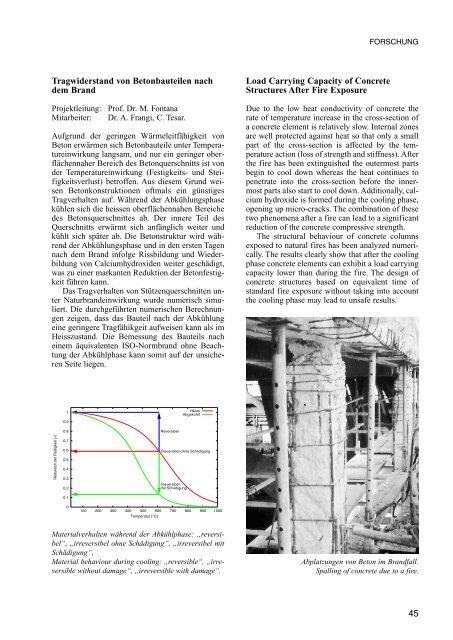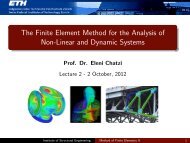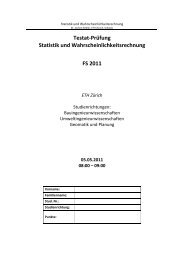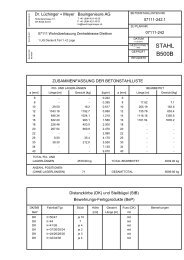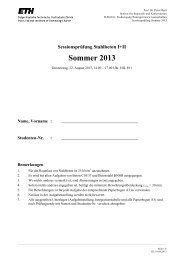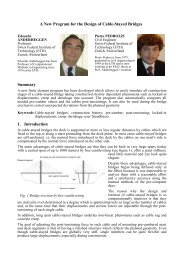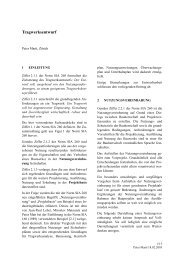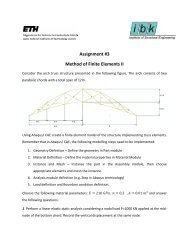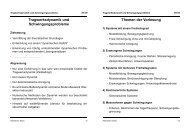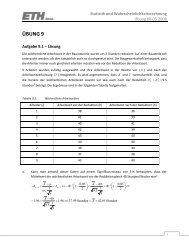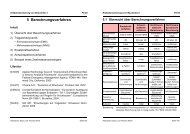IBK Jahresbericht 2004-2006 - Institut für Baustatik und Konstruktion ...
IBK Jahresbericht 2004-2006 - Institut für Baustatik und Konstruktion ...
IBK Jahresbericht 2004-2006 - Institut für Baustatik und Konstruktion ...
Erfolgreiche ePaper selbst erstellen
Machen Sie aus Ihren PDF Publikationen ein blätterbares Flipbook mit unserer einzigartigen Google optimierten e-Paper Software.
FORSCHUNG<br />
Tragwiderstand von Betonbauteilen nach<br />
dem Brand<br />
Projektleitung:<br />
Mitarbeiter:<br />
Prof. Dr. M. Fontana<br />
Dr. A. Frangi, C. Tesar.<br />
Aufgr<strong>und</strong> der geringen Wärmeleitfähigkeit von<br />
Beton erwärmen sich Betonbauteile unter Temperatureinwirkung<br />
langsam, <strong>und</strong> nur ein geringer oberflächennaher<br />
Bereich des Betonquerschnitts ist von<br />
der Temperatureinwirkung (Festigkeits- <strong>und</strong> Steifigkeitsverlust)<br />
betroffen. Aus diesem Gr<strong>und</strong> weisen<br />
Betonkonstruktionen oftmals ein günstiges<br />
Tragverhalten auf. Während der Abkühlungsphase<br />
kühlen sich die heissen oberflächennahen Bereiche<br />
des Betonsquerschnittes ab. Der innere Teil des<br />
Querschnitts erwärmt sich anfänglich weiter <strong>und</strong><br />
kühlt sich später ab. Die Betonstruktur wird während<br />
der Abkühlungsphase <strong>und</strong> in den ersten Tagen<br />
nach dem Brand infolge Rissbildung <strong>und</strong> Wiederbildung<br />
von Calciumhydroxiden weiter geschädigt,<br />
was zu einer markanten Reduktion der Betonfestigkeit<br />
führen kann.<br />
Das Tragverhalten von Stützenquerschnitten unter<br />
Naturbrandeinwirkung wurde numerisch simuliert.<br />
Die durchgeführten numerischen Berechnungen<br />
zeigen, dass das Bauteil nach der Abkühlung<br />
eine geringere Tragfähikgeit aufweisen kann als im<br />
Heisszustand. Die Bemessung des Bauteils nach<br />
einem äquivalenten ISO-Normbrand ohne Beachtung<br />
der Abkühlphase kann somit auf der unsicheren<br />
Seite liegen.<br />
Load Carrying Capacity of Concrete<br />
Structures After Fire Exposure<br />
Due to the low heat conductivity of concrete the<br />
rate of temperature increase in the cross-section of<br />
a concrete element is relatively slow. Internal zones<br />
are well protected against heat so that only a small<br />
part of the cross-section is affected by the temperature<br />
action (loss of strength and stiffness). After<br />
the fire has been extinguished the outermost parts<br />
begin to cool down whereas the heat continues to<br />
penetrate into the cross-section before the innermost<br />
parts also start to cool down. Additionally, calcium<br />
hydroxide is formed during the cooling phase,<br />
opening up micro-cracks. The combination of these<br />
two phenomena after a fire can lead to a significant<br />
reduction of the concrete compressive strength.<br />
The structural behaviour of concrete columns<br />
exposed to natural fires has been analyzed numerically.<br />
The results clearly show that after the cooling<br />
phase concrete elements can exhibit a load carrying<br />
capacity lower than during the fire. The design of<br />
concrete structures based on equivalent time of<br />
standard fire exposure without taking into account<br />
the cooling phase may lead to unsafe results.<br />
1<br />
0.9<br />
Heiss<br />
Abgekühlt<br />
Reduktion der Festigkeit [−]<br />
0.8<br />
0.7<br />
0.6<br />
0.5<br />
0.4<br />
0.3<br />
0.2<br />
0.1<br />
Reversibel<br />
Irreversibel ohne Schädigung<br />
Irreversibel<br />
mit Schädigung<br />
0<br />
100 200 300 400 500 600 700 800 900 1000<br />
Temperatur [°C]<br />
Materialverhalten während der Abkühlphase: „reversibel“,<br />
„irreversibel ohne Schädigung“, „irreversibel mit<br />
Schädigung“.<br />
Material behaviour during cooling: „reversible“, „irreversible<br />
without damage“, „irreversible with damage“.<br />
Abplatzungen von Beton im Brandfall.<br />
Spalling of concrete due to a fire.<br />
45


